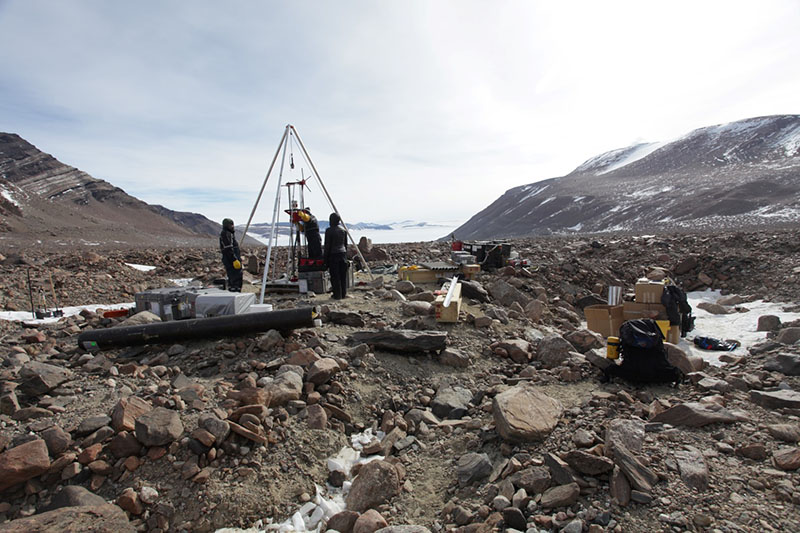Buried TreasureResearchers recover Antarctic ice of unprecedented ageTwo million-year-old ice cores contain dust, microbes pollen and maybe even DNAPosted July 26, 2018
A team of researchers has brought home from the distant mountains of Antarctica samples of some of the oldest ice ever discovered, more than twice as old as most previous samples. 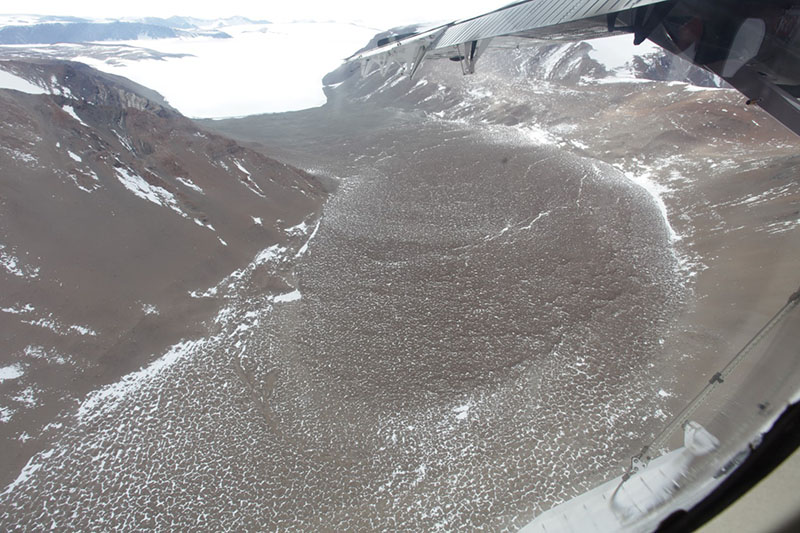
Photo Credit: Jaakko Putkonen
Looking down in to the Ong Valley from a helicopter, the debris laden floor of the valley covers up the ancient ice buried below.
In the remote Ong Valley, the team drilled into a bed of ice - that first fell as snow two million years ago, or more - buried under about a meter of dirt and rocks to obtain samples without precedent. Their find promises researchers an unparalleled glimpse into Antarctic prehistory. It’s “like opening a window into that period of time and then seeing what was the environment like, what kind of pollen was flying in the air and those kinds of things,” said Principal Investigator Jaakko Putkonen of the University of North Dakota. Putkonen’s team recovered two, 10-meter ice cores. Ice older than a few hundred thousand years old is thought to be extremely rare and only still around if it were somehow concealed from the elements. Only a handful of samples older than about a million years old have ever been recovered. With this prehistoric time capsule, Putkonen and his team are preparing to study the detritus embedded within to learn more about the ancient climates and environments of Antarctica. Currently the samples are in storage as the team prepares to process them. They’re taking it slowly because they want to be sure that they can extract the maximum information from their analysis. As no one has had access to ice core samples quite like this before, they’re still developing and perfecting some of their techniques. 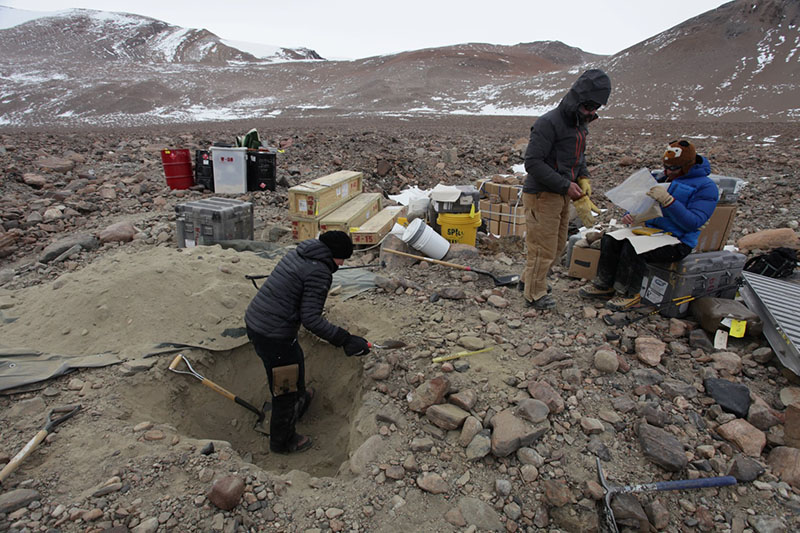
Photo Credit: Jaakko Putkonen
Marie Bergelin digs through the dirt and rocks on the valley floor while Greg Balco and Daniel Morgan (far left) look at some of the uncovered sediments.
“We haven’t really touched any of the samples yet because this is a rather new approach to how to analyze these rocks, so we have to also develop some of the methods how are we going to go about it. Also because the samples are so precious,” Putkonen said. “We want to make sure everything we do is perfect for the first time.” The research is supported by the National Science Foundation, which manages the U.S. Antarctic Program. How Ancient Ice AccumulatesGlaciers and ice sheets form when snow falls and accumulates on the ground. Year after year, more snow piles up, creating new layers and crushing the lower layers until it all fuses together and forms a solid sheet of ice. There have been many ice-coring projects throughout Antarctica that drilled down into glaciers and ice sheets that are still accumulating snow. These cores provide a complete year-by-year cross section of accumulating ice, but there are limits to how far back in time they can go. The oldest ice sample from this method extend back about 800,000 years. In order to find even more ancient ice, the team had to look in some unorthodox places. The ice Putkonen and his team were after had long since ceased accumulating snow and ice and lay buried under a thick layer of dirt and rocks, protecting it from the sun’s evaporative energy. 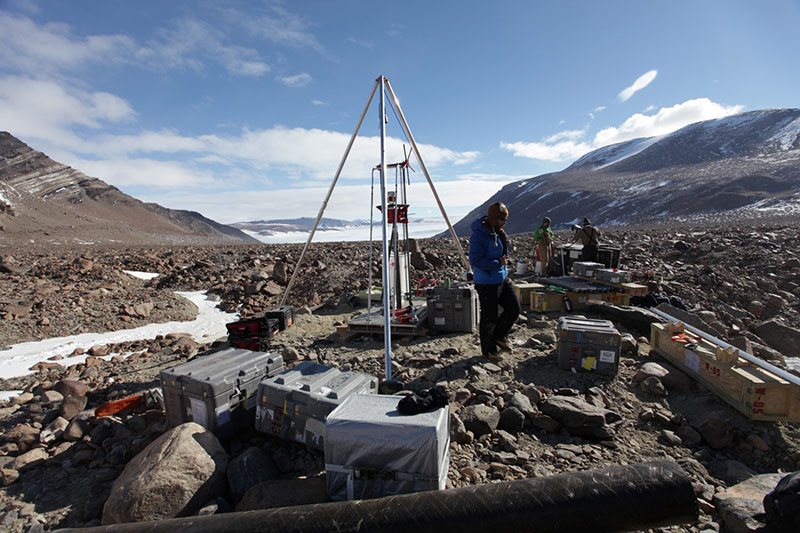
Photo Credit: Jaakko Putkonen
(Left to right) Daniel Morgan, Greg Balco and Andrew Grant set up the ice drill.
“It’s hidden, if you fly over this valley you would have no clue that there is ice there,” Putkonen said. “Once you go onto the ground and start digging into it with a shovel, after about two or three feet you run into solid glacier ice that is just sitting there.” Called “glacial till,” this debris come from rocks and dirt that was once embedded within the thick glacier. As this flowing river of ice moves over terrain, detritus gets embedded within. When the sun warms the surface of the ice, ice molecules vaporize and evaporate away. It’s a slow process called sublimation, and over many millennia can dramatically reduce the mass of a glacier. The rocks and dirt inside the ice stay behind, so over long periods of time more and more accumulate on the surface. Putkonen said that there’s evidence that the glacier in the Ong Valley was once as much as 150 feet higher than it is today. 
Photo Credit: Jaakko Putkonen
(Left to right) Greg Balco, Daniel Morgan and Marie Bergelin inspect an ice core recently pulled from the ground.
If the glacier is particularly dirty, this detritus can build up on the surface so much that it completely blocks the rays of the sun and prevents the ice underneath from sublimating away, shielding it. “That little layer of dirt gets thicker and thicker and thicker until eventually it actually kind of preserves [the ice],” said Daniel Morgan a geologist at Vanderbilt University and another principal investigator on the project. “It’s a big blanket, because [the ice] is not getting any radiation from the sun anymore.” This accumulated surface dirt is an important first step to dating the ice itself. The researchers used a technique called “cosmogenic nuclide dating” to determine how long the rocks on top have been free of the underlying ice. Rocks on the surface are constantly bombarded by cosmic radiation which causes small nuclear reactions in the rocks themselves. This changes the isotopic composition in the minerals, creating rare atoms that wouldn’t be there otherwise. These rare isotopes build up at a predictable rate over time, and the longer the rock has been exposed at the surface, the more of these rare elements build up. By looking at how many rare atomic variants there are in the rock, scientists can gauge how long it’s been at the surface. Really Tough CoringOn a previous visit to the Ong Valley in 2011, the team found that the material atop the glacier had been exposed for more than a million years. The researchers reasoned that the ice below must be even older. 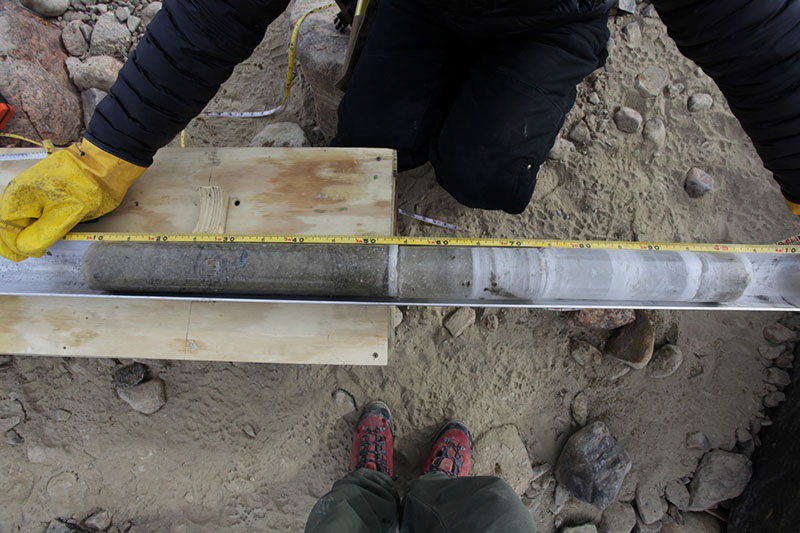
Photo Credit: Jaakko Putkonen
There was a lot of variation in the ice cores that the team recovered, some sections were clear clean ice, while others were full of rocks and sediment.
This past season the team returned with a 1,000-pound drill and full field camp to spend four weeks in the valley. Helicopters from the nearby Shackleton Glacier Field Camp moved the drill and camp into place, and the team used the drill to bore into the ice beneath the glacial till. “It was really tough coring,” Putkonen said. “What makes it difficult is that this is a mixture of ice and rock and silt and sand and everything.” Drilling through this kind of combination of ice and rock and debris hasn’t been tried before and presented a unique challenge to the drilling crew. “If it’s just rock, people know how to do that, that’s not a problem… if it’s just ice then those fellows know exactly how to do that,” Putkonen said. “When you start mixing these two it becomes really tough because if you have a drill bit that’s good for the ice, it’s not good for the rock. Then you try to find some kind of combination bit that has a little bit of both characteristics.” It was slow going. All together, over the four weeks of work the team pulled up about 10 meters of ice at each site, which a typical ice drill can extract in a matter of hours. 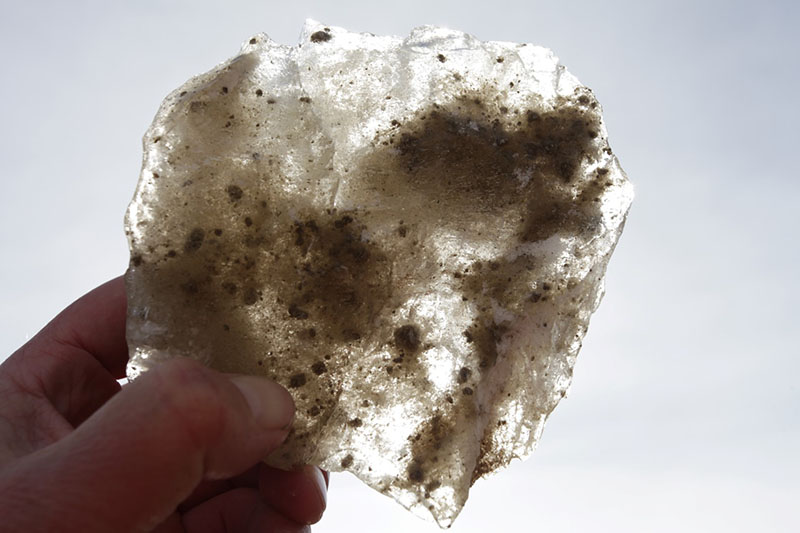
Photo Credit: Jaakko Putkonen
A researcher holds up a dirty piece of ice against the sky. Embedded within are rocks and soils that can help identify its age, as well as possibly pollen and gas bubbles from millions of years ago.
“On a great day maybe we would pull up a meter or so at a time,” Morgan said. “Sometimes we were pulling up 10-centimeter chunks at a time because we hit a rock, or we hit another layer. So it came up in all sorts of different sizes.” But their persistence paid off and the two ice cores they recovered were just what they hoped to collect. “The core itself was really stunningly beautiful,” Morgan said. “You can see all the air bubbles in the ice, you can see all the features, the little strings of silt and sand cutting across, you can see all the pebbles we cut through, the 15-centimeter chunk of granite we cut through. It really was just really quite beautiful to see it come up and just lay it out there.” These bits of rock and debris are key to precisely dating the ice cores. Though nearly all cosmic radiation gets blocked by just a few feet of ice and rock, one type of cosmic particle called a muon can penetrate much deeper. Thought it interacts with the atoms in rocks much less frequently than the protons and neutrons and other particles that make up most of the cosmic radiation at the surface, it has a similar but very subtle effect that can be carefully measured. While the rock is important to the researchers for dating purposes, other material embedded within the ice cores will tell them even more about prehistoric conditions in Antarctica. “From the air bubbles and things that are in it, we can learn something about past climates,” Morgan said. Other detritus like ancient dust, microbes and even pollen grains are also suspended in the ice as well. “They’ve actually been subsampled for some DNA samples as well. What’s going on in these things, what maybe has been preserved for million years and hasn’t seen the surfaces for a million years.” NSF-funded research in this story: Jaakko Putkonen, The University of North Dakota, Award No. 1445205. Daniel Morgan, Vanderbilt University, Award No. 1445169. Greg Balco, Berkeley Geochronology Center, Award No. 1445168. |



For USAP Participants |
For The Public |
For Researchers and EducatorsContact UsU.S. National Science FoundationOffice of Polar Programs Geosciences Directorate 2415 Eisenhower Avenue, Suite W7100 Alexandria, VA 22314 Sign up for the NSF Office of Polar Programs newsletter and events. Feedback Form |

